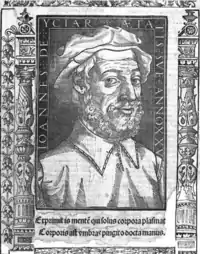Juan de Yciar
Juan de Yciar or Iciar (16th century) was a calligraphist and mathematician active in Zaragoza in the middle of the 16th century.
Juan de Yciar | |
|---|---|
 Engraving from his book | |
| Born | c. 1522–1523 probably Durango, Biscay, now Spain |
| Died | after 1572 probably Logroño, Crown of Castile, now Spain |
| Scientific career | |
| Fields | Calligraphy Mathematics |
Life and work
Little is known about the life of Juan de Yciar and it is known by his self-explanations in the preface of one of his books.[1]
Born in Durango (north of actual Spain) c. 1523, he went to Zaragoza at a young age,[2] probably due to some familiar adverse circumstances.[3] When he was fifty years old, he was ordered priest and he was living in Logroño,[4] where it is supposed he died sometime after 1573.
Yciar is known mainly by his work on calligraphy, edited first time in Zaragoza in 1548[5] titled Recopilacion subtilissima: intitulada Ortographia pratica: por la qual se enseña á escreuir perfectamente,[6] which was extended, modified and reedited many times, with different titles, during the 16th century. It is a book to teach writing in which there are from pedagogic rules[7] to different types of letters,[8] going by formulas to make inks or ways to cut quills.[9] The success of the book resides in the fact that codification of a standard legible hand was indispensable to the functioning of an imperial bureaucracy that raising imperial Spain needed.[10] The plate engravings had been made by the French engraver Juan de Vingles, who worked in several Spanish towns during the 16th century.[11] The editions of 1564 and onward had attached and annex on arithmetic written by Juan Gutiérrez de Gualda.
In 1549, and also in Zaragoza, he published a book on elementary arithmetic, with pedagogical goals, titled Arithmetica practica, muy util y provechoso para toda persona que quisiere ejercitar se en aprender a contar.[12][13] Despite the small success of this book, it is also a sample of the learning needs of the tradesmen in an era of growing of trade.[14]
References
- Echegaray Corta, pages 247–248.
- Madrid & Maz-Machado, page 118.
- Echegaray Corta, page 69.
- Echegaray Corta, page 150.
- Bohigas, page 209.
- Echegaray Corta, page 70.
- Echegaray Corta, pages 71–72.
- Echegaray Corta, pages 74–75 and 136–137.
- Echegaray Corta, page 73.
- Berenbeim, page 231.
- Bohigas, pages 325–226.
- Echegaray Corta, page 139.
- Madrid & Maz-Machado, page 117.
- Madrid & Maz-Machado, page 121.
Bibliography
- Berenbeim, Jessica (2010). "Script after print: Juan de Yciar and the art of writing". Word & Image. 26 (3): 231–243. doi:10.1080/02666280903403276. ISSN 0266-6286. S2CID 194025416.
- Bohigas i Balaguer, Pere (2001). "El libro español (Ensayo histórico)". In Antoni Badia Margarit; Germà Colón; Josep Morán Ocerinjauregui (eds.). Mirall d'una llarga vida. A Pere Bohigas, centenari. Barcelona: Institut d'Estudis Catalans. pp. 21–366. ISBN 978-84-7283-556-6.
- Echegaray Corta, Carmelo de (1907). "Calígrafos vascongados. Juan de Icíar". Revista Internacional de los Estudios Vascos = Revue Internationale des Études Basques (in Spanish). 1 and 2: Vol.1: 242–248 and Vol.2: 68–75 and 136–150.
- Madrid, Maria José; Maz-Machado, Alexander (2015). "Analysis of two Spanish arithmetic books written in the XVI century". Journal of Education, Psychology and Social Sciences. 3 (2): 117–121. ISSN 1339-1488.
- Maz-Machado, Alexander; López, Carmen; Sierra, Modesto (2013). "Fenomenología y representaciones en la Arithmetica Practica de Juan de Ycíar" (PDF). In Rico, L.; Cañadas, M. C.; Gutiérrez, J.; Molina, M.; Segovia, I. (eds.). Investigación en Didáctica de la Matemática. Homenaje a Encarnación Castro (in Spanish). Granada: Editorial Comares. pp. 77–84. ISBN 978-84-9045-095-6.
External links
- Turner, Eric Gardner. "Juan de Juan de Yciar". Encyclopædia Britannica. Retrieved 18 October 2015.